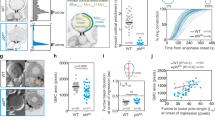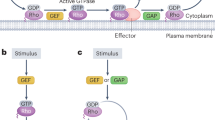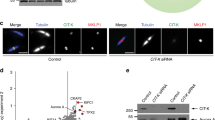Abstract
Cytokinesis requires the spatio-temporal coordination of cell-cycle control and cytoskeletal reorganization. Members of the Rho-family of GTPases are crucial regulators of this process and assembly of the contractile ring depends on local activation of Rho signalling1,2,3,4. Here, we show that the armadillo protein p0071, unlike its relative p120ctn, is localized at the midbody during cytokinesis and is essential for cell division. Both knockdown and overexpression of p0071 interfered with normal cell growth and survival due to cytokinesis defects with formation of multinucleated cells and induction of apoptosis. This failure of cytokinesis seemingly correlated with the deregulation of Rho activity in response to altered p0071 expression. The function of p0071 in regulating Rho activity occurred through an association of p0071 with RhoA, as well as the physical and functional interaction of p0071 with Ect2, the one Rho guanine-nucleotide exchange factor (GEF) essential for cytokinesis. These findings support an essential role for p0071 in spatially regulating restricted Rho signalling during cytokinesis.
This is a preview of subscription content, access via your institution
Access options
Subscribe to this journal
Receive 12 print issues and online access
$209.00 per year
only $17.42 per issue
Buy this article
- Purchase on Springer Link
- Instant access to full article PDF
Prices may be subject to local taxes which are calculated during checkout





Similar content being viewed by others
References
Yoshizaki, H. et al. Activity of Rho-family GTPases during cell division as visualized with FRET-based probes. J. Cell Biol. 162, 223–232 (2003).
Glotzer, M. The molecular requirements for cytokinesis. Science 307, 1735–1739 (2005).
Murthy, K. & Wadsworth, P. Myosin-II-dependent localization and dynamics of F-actin during cytokinesis. Curr. Biol. 15, 724–731 (2005).
Piekny, A., Werner, M. & Glotzer, M. Cytokinesis: welcome to the Rho zone. Trends Cell. Biol. 15, 651–658 (2005).
Anastasiadis, P. Z. & Reynolds, A. B. The p120 catenin family: complex roles in adhesion, signaling and cancer. J. Cell Sci. 113, 1319–1334 (2000).
Hatzfeld, M. The p120 family of cell adhesion molecules. Eur. J. Cell Biol. 84, 205–214 (2005).
Schmidt, A. & Jager, S. Plakophilins — hard work in the desmosome, recreation in the nucleus? Eur. J. Cell Biol. 84, 189–204 (2005).
Franz, C. M. & Ridley, A. J. p120 catenin associates with microtubules: inverse relationship between microtubule binding and Rho GTPase regulation. J. Biol. Chem. 279, 6588–6594 (2004).
Myster, S. H., Cavallo, R., Anderson, C. T., Fox, D. T. & Peifer, M. Drosophila p120 catenin plays a supporting role in cell adhesion but is not an essential adherens junction component. J. Cell Biol. 160, 433–449 (2003).
Skop, A. R., Liu, H., Yates, J., 3rd, Meyer, B. J. & Heald, R. Dissection of the mammalian midbody proteome reveals conserved cytokinesis mechanisms. Science 305, 61–66 (2004).
Pettitt, J., Cox, E. A., Broadbent, I. D., Flett, A. & Hardin, J. The Caenorhabditis elegans p120 catenin homologue, JAC-1, modulates cadherin–catenin function during epidermal morphogenesis. J. Cell Biol. 162, 15–22 (2003).
Skop, A. R., Bergmann, D., Mohler, W. A. & White, J. G. Completion of cytokinesis in C. elegans requires a brefeldin A-sensitive membrane accumulation at the cleavage furrow apex. Curr. Biol. 11, 735–746 (2001).
Tatsumoto, T., Xie, X., Blumenthal, R., Okamoto, I. & Miki, T. Human ECT2 is an exchange factor for Rho GTPases, phosphorylated in G2/M phases, and involved in cytokinesis. J. Cell Biol. 147, 921–928 (1999).
Saito, S. et al. Rho exchange factor ECT2 is induced by growth factors and regulates cytokinesis through the N-terminal cell cycle regulator-related domains. J. Cell Biochem. 90, 819–836 (2003).
Saito, S. et al. Deregulation and mislocalization of the cytokinesis regulator ECT2 activate the Rho signaling pathways leading to malignant transformation. J. Biol. Chem. 279, 7169–7179 (2004).
Kimura, K., Tsuji, T., Takada, Y., Miki, T. & Narumiya, S. Accumulation of GTP-bound RhoA during cytokinesis and a critical role of ECT2 in this accumulation. J. Biol. Chem. 275, 17233–17236 (2000).
Kim, J. E., Billadeau, D. D. & Chen, J. The tandem BRCT domains of Ect2 are required for both negative and positive regulation of Ect2 in cytokinesis. J. Biol. Chem. 280, 5733–5739 (2005).
Anastasiadis, P. Z. & Reynolds, A. B. Regulation of Rho GTPases by p120-catenin. Curr. Opin. Cell Biol. 13, 604–610 (2001).
Reynolds, A. B., Daniel, J. M., Mo, Y. Y., Wu, J. & Zhang, Z. The novel catenin p120cas binds classical cadherins and induces an unusual morphological phenotype in NIH3T3 fibroblasts. Exp. Cell Res. 225, 328–337 (1996).
Grosheva, I., Shtutman, M., Elbaum, M. & Bershadsky, A. D. p120 catenin affects cell motility via modulation of activity of Rho-family GTPases: a link between cell–cell contact formation and regulation of cell locomotion. J. Cell Sci. 114, 695–707 (2001).
Noren, N. K., Liu, B. P., Burridge, K. & Kreft, B. p120 catenin regulates the actin cytoskeleton via Rho family GTPases. J. Cell Biol. 150, 567–580 (2000).
Hatzfeld, M., Green, K. J. & Sauter, H. Targeting of p0071 to desmosomes and adherens junctions is mediated by different protein domains. J. Cell Sci. 116, 1219–1233 (2003).
Yoshizaki, H. et al. Cell type-specific regulation of RhoA activity during cytokinesis. J. Biol. Chem. 279, 44756–44762 (2004).
Itoh, R. E. et al. Activation of rac and cdc42 video imaged by fluorescent resonance energy transfer-based single-molecule probes in the membrane of living cells. Mol. Cell Biol. 22, 6582–6591 (2002).
Rackham, O. & Brown, C. M. Visualization of RNA–protein interactions in living cells: FMRP and IMP1 interact on mRNAs. EMBO J. 23, 3346–3355 (2004).
Huttelmaier, S. et al. Spatial regulation of β-actin translation by Src-dependent phosphorylation of ZBP1. Nature 438, 512–515 (2005).
Hatzfeld, M. & Nachtsheim, C. Cloning and characterization of a new armadillo family member, p0071, associated with the junctional plaque: evidence for a subfamily of closely related proteins. J. Cell Sci. 109, 2767–2778 (1996).
Bostock, C. J., Prescott, D. M. & Kirkpatrick, J. B. An evaluation of the double thymidine block for synchronizing mammalian cells at the G1–S border. Exp. Cell Res. 68, 163–168 (1971).
Hu, C. D. & Kerppola, T. K. Simultaneous visualization of multiple protein interactions in living cells using multicolor fluorescence complementation analysis. Nature Biotechnol. 21, 539–545 (2003).
Acknowledgements
We thank J. Achilles for expert technical assistance, and T. Magin and M. Osborn for critically reading the manuscript. This work was supported by grants from Deutsche Forschungsgemeinschaft (DFG; SFB 610 to M.H.) and the Bundesministerium für Bildung und Forschung (BMBF; Wilhelm Roux programme to M.H. and NBL3-Junior research group to S.H.).
Author information
Authors and Affiliations
Corresponding author
Ethics declarations
Competing interests
The authors declare no competing financial interests.
Supplementary information
Supplementary Information
Supplementary figures S1, S2, S3, S4 ,S5 and S6 (PDF 892 kb)
Rights and permissions
About this article
Cite this article
Wolf, A., Keil, R., Götzl, O. et al. The armadillo protein p0071 regulates Rho signalling during cytokinesis. Nat Cell Biol 8, 1432–1440 (2006). https://doi.org/10.1038/ncb1504
Received:
Accepted:
Published:
Issue Date:
DOI: https://doi.org/10.1038/ncb1504
This article is cited by
-
Intratumor δ-catenin heterogeneity driven by genomic rearrangement dictates growth factor dependent prostate cancer progression
Oncogene (2020)
-
Molecular impact of selective NFKB1 and NFKB2 signaling on DLBCL phenotype
Oncogene (2017)
-
δ-Catenin, a Wnt/β-catenin modulator, reveals inducible mutagenesis promoting cancer cell survival adaptation and metabolic reprogramming
Oncogene (2015)
-
Molecular genetics and clinical features of Birt–Hogg–Dubé syndrome
Nature Reviews Urology (2015)
-
Direct RNA sequencing mediated identification of mRNA localized in protrusions of human MDA-MB-231 metastatic breast cancer cells
Journal of Molecular Signaling (2013)



